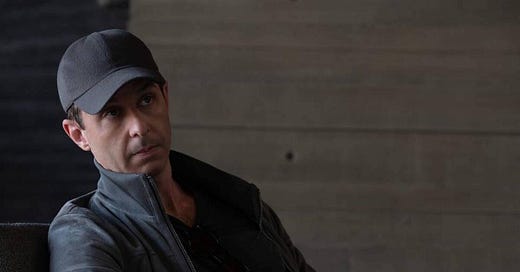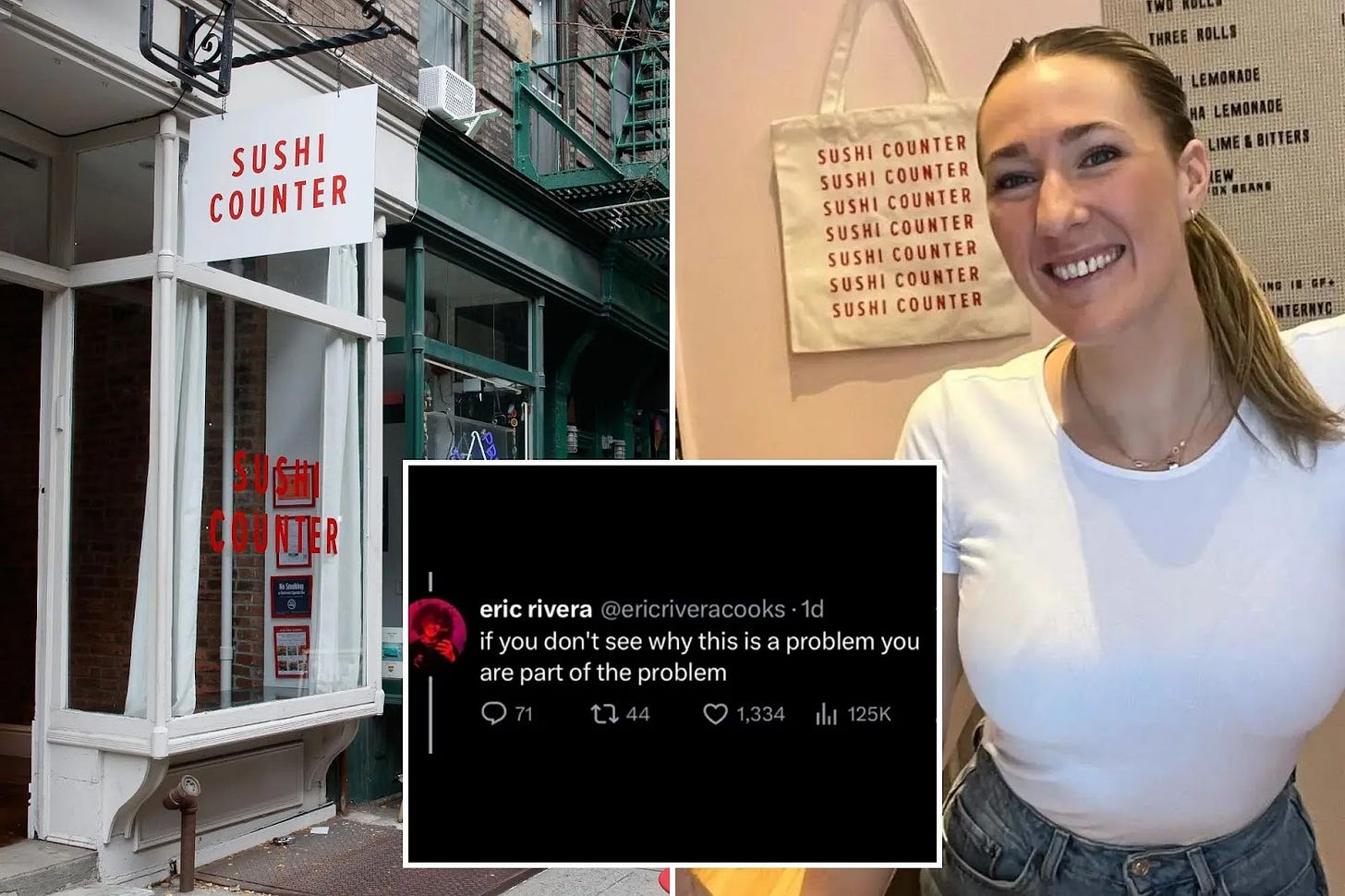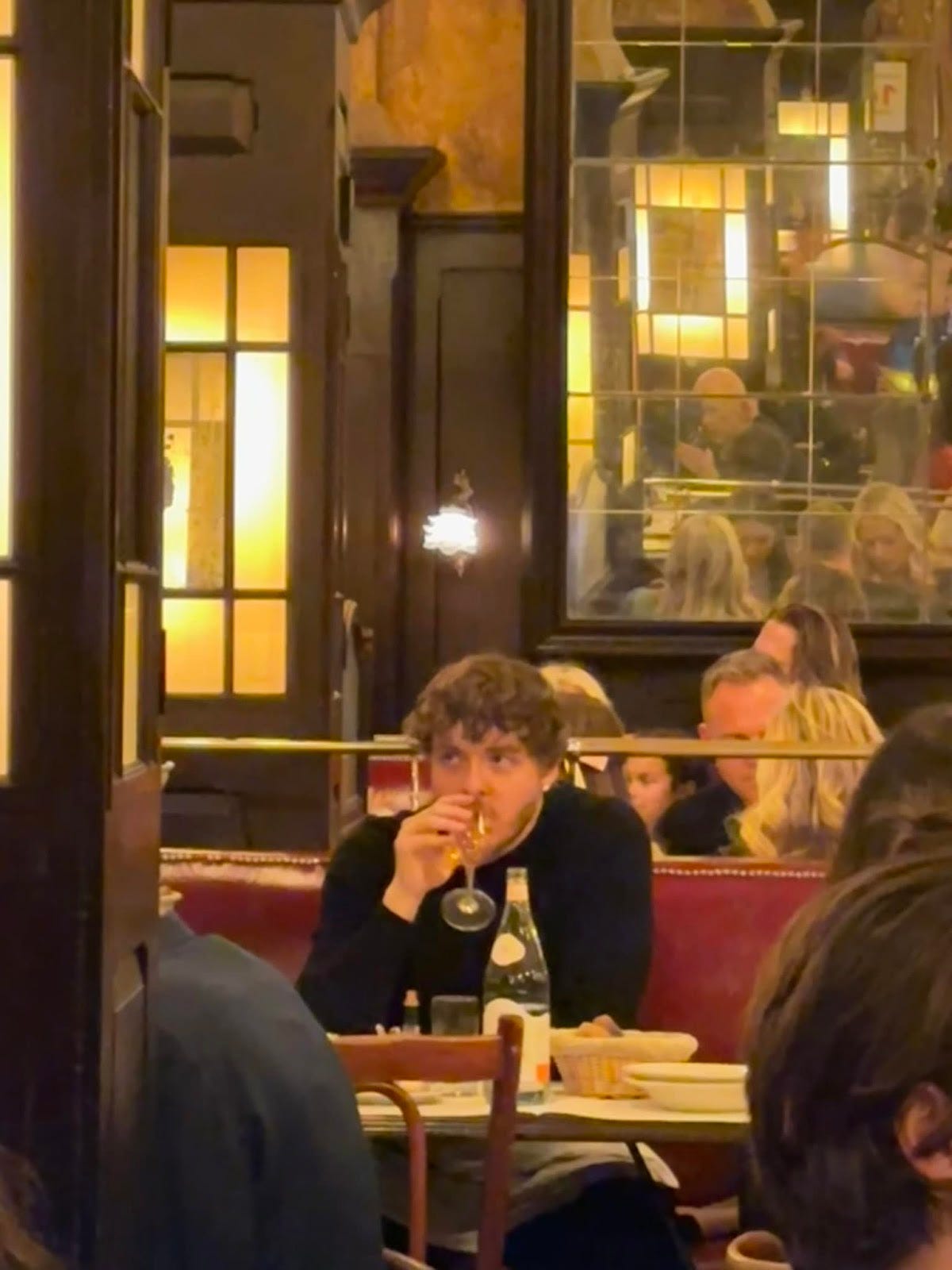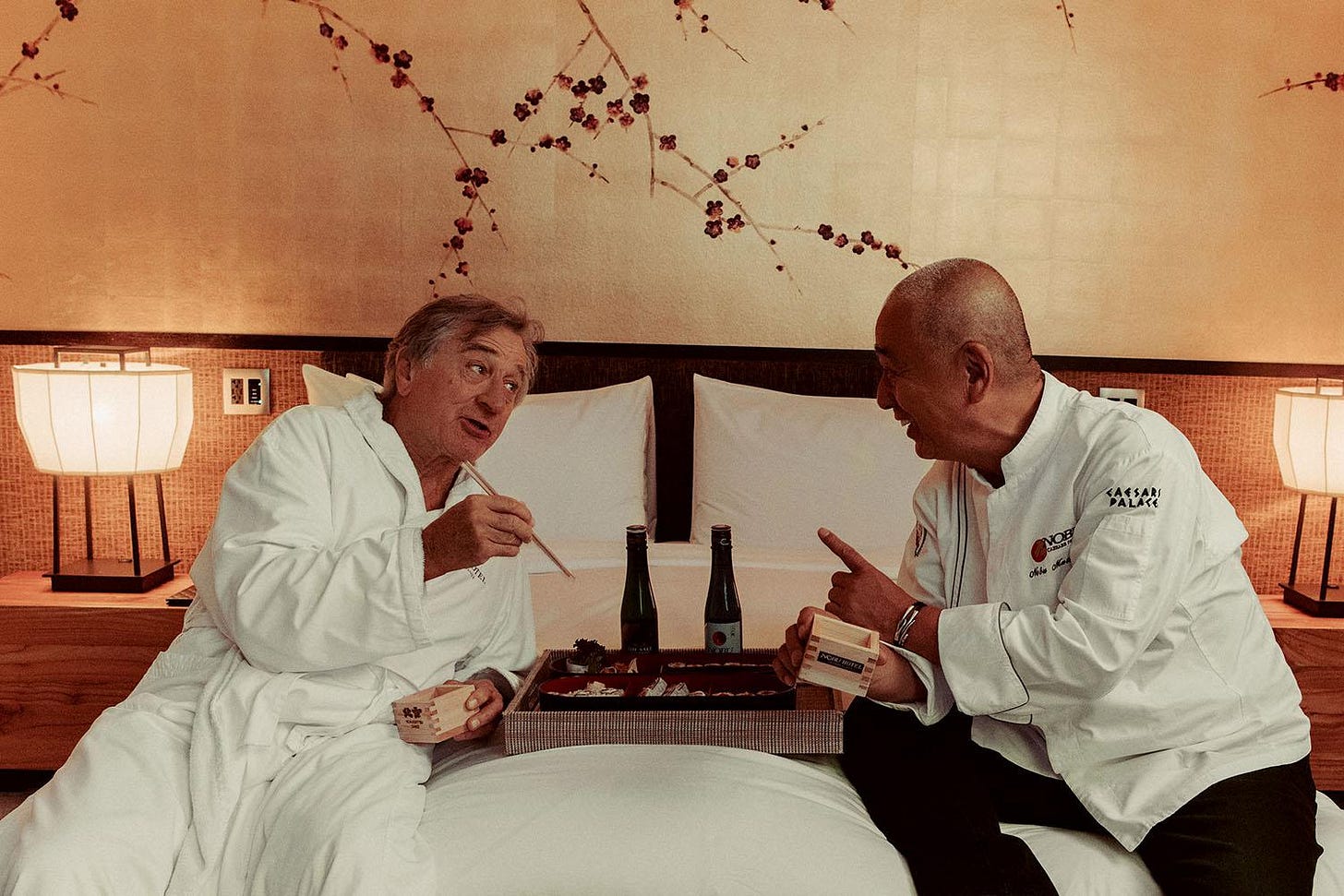There is an epidemic plaguing the restaurant reservation apps of New York City. It's not that there are no tables to book—this is a separate problem that I don’t care as much about—but that there is only omakase. I previously wrote about sushi clubstaurant BONDST and its renewed popularity among young people looking more for loud music and drinking, less for eating. This is not what I am talking about. What if you’re just looking for a date night spot: Valentine’s Day, an anniversary, the one free night during the week that you get to spend with your partner. Many in New York City reach for sushi, and they are not strapped for options.
Why is this happening? Sushi has been a staple food among New York City’s cultural and financial elite long enough to be thoroughly lampooned by Bret Easton Ellis in Glamorama. It is food for people who don’t care about eating, pretending to consider the nuances of yellowtail vs. toro, of farmed filets vs. fish flown in from Japan that morning. It can be bland and light, the perfect dinner for ending date night with a hook up. And for as barebones a dish as sushi can be, it’s often the most transparently materialistic you can find: omakase price factors in express freight airfare and the labor of one “master.” Can you believe Chef Gari served me uni with his own hands? The $400 was so worth it, dude.
But what of chains like Wasabi, SUGARFISH, and KazuNori, which serve raw fish and seasoned rice at a fraction of any multi-hundred dollar omakase price tag? Sure, it’s not “the best,” but it's still pretty good, and totally edible, in a way that fast-casual pasta is not. That’s why paying so much for sushi is so offensive to me: it's a direct question of accessibility. You can make delicious pasta with flour, eggs, water, olive oil, butter, garlic. You cannot make great sushi without the best fish, or the wisest master (omakase is “chef’s choice,” after all) who knows not only the correct ratio of rice to seasoning, but also exactly how much money he is swindling his diners out of.
Despite this, there is no dearth of sushi in New York City, and new omakase “counters” appear nearly as often as smoke shops. Some compete by offering the lowest price possible, which does not make sense: these are places for well-endowed nouveau finance boyfriends to take their girlfriends on a carelessly planned date night, or, they are places for the culinarily uninitiated to spend hundreds and pretend to feel good about it. If you want a budget date night, learn to cook or get over your anxiety and try a walk-in at Thai Diner. But if you’re spending $60 a head on omakase, you are evading its purported point altogether: a quiet luxury experience to match his Loro Piana and her KHAITE.
While “quiet luxury” has afflicted how people dress and want to dress—like they actually have money, or like they want to have good taste without trying very hard—its analogue in the world of dining is the omakase set. But when you spend $1,000 on trousers from KHAITE, you get to wear them more than once. Blowing a grand on various bites of fish for two is asinine. That’s not a worthy experience, not the American way.
But what is a worthy experience? For Christmas, my girlfriend’s mom got us a gift certificate to eat “breakfast at Tiffany’s,” like from the movie. We were finally able to secure a Sunday reservation a few weeks ago, and it was far from luxurious. The vibe at the Tiffany store is like Heathrow Airport but with one single-use bathroom. It is located next door to Trump Tower in midtown and the only people inside are tourists holding merchandise from Trump Tower. The food isn’t even bad, but the service made me feel like the man who fell to Earth. We watched in awe as a waitress removed bags and coats from a spare chair at a neighboring table. Apparently, it was needed for another party. Like everywhere else in midtown, seating is in short supply at Tiffany’s.
But this didn’t really surprise me. Daniel Boulud, the man behind the “Blue Box Cafe” at the Tiffany store, is the French equivalent to a sushi master chef, purveying particular service with banal cuisine. To be fair to Bouloud, the dining space has only been his so long, and is more than anything a device to capture tourists from 5th Avenue via an en vogue prix fixe menu. But, then again, as third-party bids for Resys skyrocket in price among the visiting elite, what popular restaurant isn’t a tourist trap?
Luckily our experience at Blue Box was a gift, because my madeleine and croissant and “Golightly” juice were not worth $68 of my own money. But I can’t imagine anyone there enjoying themselves, just like I can’t imagine anyone enjoying themselves at omakase counters. Tourists and girls who hate each other whipping out high-APR credit cards to spend hundreds on tea-towers of just-fine sandwiches and pastries is high society cosplay. It’s not quiet luxury, but it’s not particularly loud, either. Glorified high tea is not the American way.
George Matthews recently sent me a Substack post from the end of last year about how “you don’t need to hit all the hype restaurants,” in which the author lists off all the un-hype restaurants where he feels confident in getting a table regularly. Cervo’s, Stir Crazy, Frenchette… right… not hype.
What he means though, and what he silently concedes, is that he might just want to start cooking at home and “hosting a lot more.” I need to spend less money, too. So, I agree in part with his thesis. Not that it’s actually kind of dope to call hype restaurants awesome just because a year or two has passed since their openings, but that eating out in New York City should not make you resentful of yourself or others who have bought into the hype economy of modern food media. You shouldn’t be rationalizing the credit card points on any night out: well, that wasn’t that great, but at least I’ll earn 4x on that purchase. You also shouldn’t be wearing AirPods at any restaurant, even if you’re just dining solo at Balthazar. Footnote: Does anyone know if Pete Wells’ building is rent-stabilized, and when he moved in? Talk about quiet luxury.
In New York City you should stop reading The Infatuation, stop looking at Resy or paying attention to where rich old people spend their money and wear their Apple products. Instead, search for experiences that you will be able to talk about for years, restaurants that equalize the high and low, the young and old, the rich and poor, like the best of this city so often does. These should be restaurants where you think you might enjoy yourself, not just places you need to go because they’re in a historic building and have an epic pastry program.
Consider Nobu. Not the original, necessarily, but Nobu as a concept. It’s a massive space that always has a table, but it's not for everyone. Although its name persists, it’s not definitively “hype.” It’s Nobu. My girlfriend and I went to the 57th St. location—aptly named Nobu Fifty Seven—the night before our lackluster Tiffany’s experience. We booked the earliest table we could, but the upstairs dining room doesn’t actually open until 5:30 PM, so arriving early meant standing awkwardly amongst other eager parties who asked the be-suited host be-accented questions like: “Can we take photos on the stairs?” This is what I crave; not dead eyes and stick-and-poke from both worker and patron alike.
Our table was set for four, but large enough for at least six—so massive that we couldn’t even hold hands across: it was like I was Neil McCauley, and Clare was Vincent Hanna. This is what restaurants should strive to evoke. Chef Nobu and Robert De Niro have perfected ambiance such that, even at an uncomfortably large table, with seat neighbors like a birthday party where one guest brought a Trader Joe’s branded orchid as a gift, or a celebratory gaggle of Gen Alpha teens who wouldn’t stop staring at my girlfriend, I never once doubted I was experiencing unique culinary luxury well worth my money.
It’s not even that the food is incredible (though, the service is in a class of its own). Some of it is bad, like the sushi tacos. Some of it is boring, like the baked alaska which is fine but not really baked alaska. Some of it is truly worth the price of admission, like the miso black cod. And some of it is totally unexpected, like a buckwheat brownie with sobacha ice cream. All of it, though, announces itself as Nobu, an institution that persists despite trends and food trend forecasters passing it by. As we left, I nearly tripped down the steps marveling at the room. Not a Resy notification in sight (I booked on OpenTable).
I did notice, though, that Nobu has a sushi counter and omakase menu for those who are intent on not getting the full experience. Its clientele, as far as I could tell, included a techy rich man wearing a Cotopaxi puffer jacket. He might as well have been wearing AirPods, too. At any given omakase counter, there is no shortage of guys like this: they’ve infiltrated New York City and its dining culture, made it Vaynerchuked up, just like sushi and Resy. This is the final betrayal of omakase and its faux-intimacy: at a counter of 12, you might have to talk to someone who “eases his mind” in Jackson Hole. There’s nothing quiet about that. “Just like Japan,” he might muse. Do they say the same about America at Nobu Tokyo?










the mystery ice cream place in the east village is a version of this
if someone else picks my food for me it’s either really fancy and special or more fun